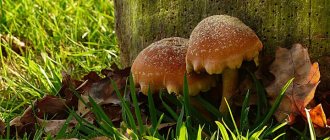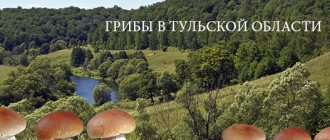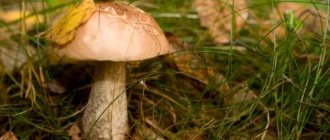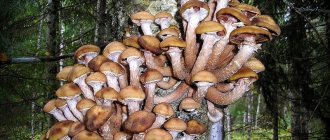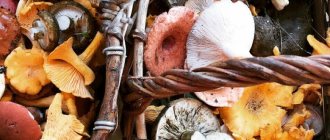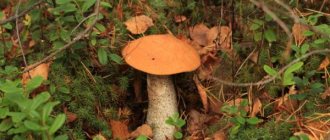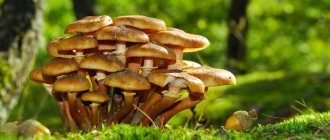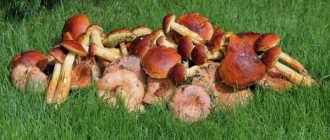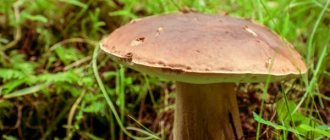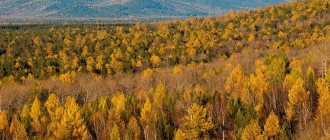Spring season
Early morel mushrooms and morel caps open the season. They appear with the first thaw in the spring after the snow melts. In the Omsk region, morels grow in the Tara region, where mushroom pickers have been finding them since mid-May. In forest plantations closer to Omsk, they may appear earlier if the end of April was not characterized by severe frosts. Popular wisdom says that a bountiful harvest of morels occurs in rainy years after the lungwort begins to bloom. And also the catkins on the aspen fly around, the first birch leaves appear, and the bird cherry blossoms.
In ravines and near ponds, it is worth looking for tasty mushrooms near willows - these trees retain moisture well around the roots, creating a microclimate favorable for the ripening of fruiting bodies. In poplar plantings, of which there are many in the region, in addition to morels, rows, oyster mushrooms and milk mushrooms also grow. There are also a lot of poplar undergrowths near the Irtysh. It is also worth looking into the birch groves. In the northern part of the region, the morel-like morel cap predominates. Both mushrooms are edible; they can be distinguished by the following characteristics:
- morels have a conical cap that resembles a cap;
- the morel cap is not fused at the bottom edge with the stem;
- In cross-section, morels are hollow.
Near the village of Tevriz, mushroom pickers collect full baskets already in early May, provided that the previous week was warm enough. By the end of May, mushroom rows are replenished with rows of mushrooms, summer mushrooms and even boletus mushrooms. Morels love saline soil, mixed forests with shrubs (deadwood, willow, maple, small aspen).
They grow in the vicinity of the village of Podgorodka, along the Cherlaksky tract, in the Muromtsevo and Maryanovsky districts, around Lake Danilov, near the Krasnoyarsk tract along the dacha settlements. They are also found along the Pushkinsky tract. On the territory of “Green Island” and Victory Park, persistent mushroom pickers are harvesting right within the city. Along the highway towards Novosibirsk, popularly called the concrete road, you can also collect full baskets from the first weeks of May. But if you step away to the side - mushrooms easily accumulate toxins from exhaust gases, there will be little benefit from such a delicacy. Spring mushrooms bear fruit for 2-3 weeks and quickly disappear, replaced by new ones.
Ryzhik
This mushroom is rightfully classified in the first category. The cap of the saffron milk cap is reddish-red on top with a funnel-shaped depression in the center. The lower part of the cap seems to be made of orange plates. The leg is short, also orange, hollow, and looks like a ring when cut. At the break of the mushroom, orange-red juice immediately releases. You touch the orange plates, give them a little squeeze, and they immediately turn green. Rizhik, unlike other mushrooms, is incomparably fragrant. In total, there are two forms of saffron milk caps. There are other varieties, but they are rarer. Pine or bog mushroom is the most common type of this mushroom. The cap reaches 5-10 centimeters in diameter. Mushrooms prefer sandy loam soil. Their color (even in cross-section) is bright orange. Copper-red shades may also predominate. In total, there are two forms of saffron milk caps. There are other varieties, but they are rarer. Pine or bog mushroom is the most common type of this mushroom. The cap reaches 5-10 centimeters in diameter. Mushrooms prefer sandy loam soil. Their color (even in cross-section) is bright orange. Copper-red shades may also predominate. In total, two forms of saffron milk caps are distinguished. There are other varieties, but they are rarer. Pine or bog mushroom is the most common type of this mushroom. The cap reaches 5-10 centimeters in diameter. Mushrooms prefer sandy loam soil. Their color (even in cross-section) is bright orange. Copper-red shades may also predominate.
Summer gathering
In June there is an active wave of boletuses, which are collected in young forest plantations (50-100 km from Omsk towards Muromtsevo); honey mushrooms and boletuses are found in the Ryazan region. In July and August, delicious boletus mushrooms grow in the forest behind Petropavlovka (towards Sedelnikov, about 3 km from Muromtsevo). Near Lyubino (you can also get there by train) cowsheds are collected; they grow abundantly in the undergrowth and small birch forest. 50 km from Omsk along the Pushkinsky tract, boletuses are collected. In Tyukalinsk, near Malinovka, you can find boletus, mushrooms, milk mushrooms, and moss mushrooms. There are also mushroom places just outside the village of Klassino. In the Sargat region (landmark - forests near the Gazprom gas station) boletus and mushrooms are collected.
Boletus
The young boletus is beautiful when its pink cap has not yet blossomed. And it received another name - red-headed - for the color of the “headdress” - the hat. The lower part of the cap of a young mushroom is white, a little later - brown-gray, the stem is cylindrical, sometimes high, with a network of dark scales. It quickly turns blue when cut. Determining the place of formation and development of myceliums at first glance may seem difficult. But everything is much simpler. If we compare boletuses, for example, with the same boletus, then, unlike the latter, boletuses prefer not any specific trees for growth, despite their name, but rather deciduous forests in general. The best trees for fruit growth and development: aspen, poplar, birch. The place where boletus grows is often the soil near willows, oaks, and beeches. The quality of the soil is also important for the development of fungi. It is better if it has a high content of sand and peat. This soil composition will provide a beneficial effect on the formation of the mycelium itself. The peak yield of forest fruits occurs in mid-summer - July. Don’t forget that redhead is also an autumn mushroom, as it grows with minor pauses in suitable areas of soil until the first frosts of October.
Autumn mushrooms
In the vicinity of Malakhovo, along the highway to Tyumen, 30-50 km from Omsk, in the September warmth, aspen boletuses begin to grow. In Azov there are saffron milk caps and boletus. Since October, milk mushrooms have appeared in Chernoluchye (on the right side), Syropyatsky, near Krutaya Gorka and towards the Political Department. Not far from the village of Ryazan and near Davydovka, boletus and moss mushrooms are collected. Near the village of Pokrovka (to the right of the railway crossing) there are rows of rows in abundance.
In the first ten days of November, islands of milk mushrooms can still be found; they are well preserved under the snow, in hummocks under moss and dried grass. They grow in the vicinity of Alekseevka, Gorky district, Kormilovka, Pobeditel, beyond Krasny Yar in birch forests, in pine forests near Dachnoye, next to Berlinka.
Oyster mushrooms grow abundantly in Zvonarevy Kut, towards Krutaya Gorka, near the village of Russkaya Polyana, in poplar plantings towards the Ostrich Farm. They are found on the stumps of poplars, fallen birches, in the roots of old willows, and on dead coniferous trees. After the November frosts, the mushroom season in the Omsk region can be considered closed. Occasionally you come across small colonies of flamulins (winter honey mushrooms), which delight casual mushroom pickers until the warmth of spring.
The richest mushroom spots in 2022 are:
- Blueberries and lingonberries grow almost throughout the entire territory of the Muromtsevo region - from the village of Artyn and further north. But we can highlight the most mushroom and berry places - near the villages of Rezany and Porechye, in the territory of the rural settlements of Kondratyevskoye and Karbyzinskoye.
- In the Sedelnikovsky district, mushrooms can be found in large quantities near the villages of Denisovka and Petropavlovka, berries (lingonberries, cranberries, and a little later there will be blueberries) - in the territory of the village of Unara, the villages of Ust-Intsy and Bogomel.
- In the Tara region there are a lot of mushrooms near the villages of Ekaterininskoye and Bazhenovo, berries (lingonberries, blueberries, blueberries) - near the village of Bobrovka and the village of Bazhenovo.
- In the Ust-Ishim region, mushrooms and berries (cranberries and lingonberries) are found close to all populated areas. Boletuses and boletuses are found even in Ust-Ishim itself.
- In the Tevriz region there are a lot of mushrooms and berries near the village of Bely Yar and the village of Kuznetsovo. A good harvest of mushrooms can also be found near the village of Ermilovka.
- In the Znamensky district, mushrooms and berries (lingonberries, blueberries) are abundant near such settlements as Ust-Tamak and Novoyagodnoye (right and left sides of the road).
Related material: Where to collect oyster mushrooms and how to grow them at home
In other areas of the region, cranberries, lingonberries, blueberries and blueberries cannot be found, but mushrooms, as they say, are apparently invisible. More detailed information about possible places for collecting berries and mushrooms can be obtained from the forest districts of the northern regions of the region.
Mushroom places in the Omsk region.
Features of the region
The territory of the West Siberian Plain is characterized by flat topography. There are steppes, they smoothly turn into forest-steppes and dense forests, right up to swampy taiga places in the north.
There are several important features that allow you to harvest a good harvest.
- Vast areas of deciduous, coniferous and mixed forests.
- Fertile soil.
- Short heavy rains and sunny weather.
- High humidity levels.
In the Omsk region, mushrooms are highly valued. They are prepared for future use: salted, pickled, dried. The preparations are added to the first and second courses, and served as an appetizer. Dishes with fried mushrooms are always in demand.
Treating people with gifts from the forest is a Siberian tradition. This is a vegetable protein with high nutritional value, beneficial microelements and vitamins.
The season begins in May and continues until autumn.
What mushrooms and where to look for them
Depending on the site, different species grow in the Omsk region:
- russula: grow in Pavlogradka;
- boletus: common in Pavlogradka, Gorky, Omsk, Tarsky, Sedelnikovsky, Ust-Ishimsky, Znamensky districts;
- cowsheds (thin pig): grow in Pavlogradka, Omsk, Poltava, Lyubinsk, Kormilovsky, Sedelnikovsky districts, Kalachinsk (Selena gardens);
- porcini mushrooms: grow in Gorky, Kormilovsky, Muromtsevo, Tarsky, Tevriz regions;
- boletus: common in Cherlak, Muromtsevo region;
- champignons, honey mushrooms: they can be collected in the Omsk region;
- boletuses: feel great in the Azov, Poltava, Ust-Ishim regions;
- milk mushrooms: common in the Muromtsevo region.
- Sargat district - boletus;
- Gorky district – boletus mushrooms;
- Nizhneomsky district - boletus, boletus, milk mushrooms, chanterelles (the village of Lokti, as well as at the 150th kilometer of the highway);
- Tyukalinsky district - chanterelles, porcini mushrooms, boletus mushrooms;
- Kolosovsky district – boletus and boletus;
- Krutinsky district - mostly boletus;
- Tevriz district - boletus, boletus, porcini mushrooms;
- Azov region - cowsheds, boletus fields;
- Tauride region - milk mushrooms, barnacles, boletus;
- Sherbakul district - oyster mushrooms;
- Muromtsevo district - aspen mushrooms, boletus mushrooms, milk mushrooms, cow mushrooms, porcini mushrooms.
Poisonous
Where such a fabulous abundance of mushrooms is presented, the matter simply cannot do without the presence of poisonous species that are dangerous to human life. The forests of the Omsk region are no exception. The most commonly encountered toxic species are:
- red fly agaric and other species of this family;
- all types of toadstools;
- false champignons that do not turn red, but turn yellow when cut;
- rows and talkers;
- gall or satanic mushroom;
- fibers and lepiots.
for.the.wild
bo_diesel78
There are also various other varieties of dangerous species. Even one of them, once in the basket, can poison all other edible mushrooms. The rule here is “If you don’t know, don’t take it!” even more relevant.
Dangers for mushroom pickers in the forest
You can get lost in the forest. Therefore, do not go into the forest alone if you are not familiar with the terrain. It's better to wear something bright so that if you get lost, you can be easily found. Always tell your friends that you went to the forest to pick mushrooms: if you don’t get in touch for a long time, they will understand that something has happened and will turn to the Ministry of Emergency Situations for help. There is also a possibility of encountering wild animals; no one is immune from this.
Before going into the woods, you should check the news reports - sometimes there are reports of bears appearing in wooded areas. If a bear appears, do not run, do not turn your back to the animal and do not scream. You need to behave the same way if there is a wolf in front of you. Do not try to run away from the animal, as it may develop a pursuit reflex, which is often stronger than fear of a person. Stand still and wait for the animal to leave, or back away slowly.
Interesting read: White milk mushroom and its doubles
Inedible
Along with the wealth and variety of noble and simply edible mushrooms, Omsk forests are also fraught with unpleasant surprises in the form of inedible and poisonous mushrooms. There is a significant difference between these two classes.
Expert opinion
Gennady Sergeevich Rylov
A great expert in mycology and an avid mushroom picker. Knows everything about mushrooms, their types and places of growth
If poisonous ones can cause serious food poisoning and even death, then the name “inedible” speaks for itself. However, some of them are not only unpleasant in taste, but also contain various toxins and harmful substances that can accumulate in the human body and, over time, cause significant damage to his health.
The most famous inedible mushrooms found in the Omsk region are the following:
- the vast majority of tree species;
- black breast;
- pig;
- line;
- dark milky;
- most types of false mushrooms.
maharynski
andrei_forester
heartignet
tineoenvertical_linares
In order not to make a mistake and not harm the health of yourself and others, a mushroom picker should strictly follow the simple golden rule: “If you don’t know what kind of mushroom, don’t take it!”
How to pick mushrooms correctly
There are two ways to collect mushrooms - cut them with a knife or carefully unscrew them by the roots. Both methods have their drawbacks. For many years, mushroom pickers have been arguing about the correct way to collect mushrooms, but there is no clear answer. Personally, I cut the mushrooms with a knife and immediately check them for worms. By the way, mushrooms that grow in groups (for example, honey mushrooms) or on trees (oyster mushrooms) are simply impossible to unscrew. Mushrooms should be collected away from roads. It is better to put it in a basket: it provides free access of air and the mushrooms do not wrinkle in it. Almost all mushrooms grow in families: if you find one, look for another nearby!
Butter
There are several types of them. But in the taiga forests of Siberia and the Urals the main one is the oiler
, or, as it is also called,
granular oilseed
. Its cap is covered on top with a yellowish-brown or brown thin but dense film, which is easily removed. But in damp weather, the film on the cap becomes sticky and slimy. In young fungi, the edges of the cap are connected to the stem by a white film, which over time comes off the cap and remains on the stem in the form of a dark ring. The spongy part of the cap is tender, light yellow, the stem is short. The flesh of the oiler is cool. You will take such a mushroom in your hand, like a piece of fresh butter from the refrigerator.
Chanterelle
The mushroom is edible; culinary experts undeservedly included it in the third category. The fox got its name because of its yellow color. The fungus is like an egg yolk, and when there are a lot of them, it’s like a living omelette frozen on the grass. Take a closer look at them and see how the delicate yellow folds of the plates fancifully branch out all the way to the ground along the tapering stem. The sinuous and raked edges of the corrugated caps are beautiful. Chanterelles deserve not only the attention of mushroom pickers, but also respect. Chanterelles always grow in large families, sometimes occupying entire meadows. When young, the mushrooms are convex, quite neat, aligned, sometimes arranged in rows. The more “older” ones have a high leg, an even cap, they are fleshy, dense - the joy of a mushroom picker. But the smell of chanterelles is especially pleasant; it is typical for this type of mushroom, and it certainly cannot be confused with any other. Some mushroom pickers, praising mushrooms, describe this smell as a mixture of steamed birch leaves and mint.
With age, only one thing changes in chanterelles: their elastic young body acquires a more rubbery structure, especially in dry weather, and becomes flabby in damp weather. Towards the end of summer, the cap of the mushroom takes the shape of a funnel, the edges of which often become uneven, as if torn.
Chanterelles are especially loved by mushroom pickers because they are not damaged by parasites, thanks to their special chemical composition; except that the wireworm sometimes gets into the body of the chanterelle, but this happens very rarely. In addition, chanterelles are completely unpretentious to weather conditions; they can suddenly be discovered in the midst of summer, when there are very few mushrooms in the forest; this season is also called “inter-mushroom” by lovers of “quiet hunting”.
Valuy
Other names: goby
,
crying mushroom
and
snot mushroom
. This taiga mushroom is easy to recognize. The hat of young Valuevs is like a small slippery ball, and those of older ones spread out with a flat roof. Some mushroom pickers do not collect valui, because if they do it, the basket will fill up very quickly. But why disdain these edible mushrooms, although they belong to the third category? So, mushroom pickers need to know that the valui goby is very tasty when pickled, when there is only one there, i.e. without admixtures of other taiga mushrooms. The best time to collect values is when they are born in herds. And there is no need to be afraid of the acrid taste of raw mushroom; it completely disappears when pickled. But it is better to salt the valui in a hot way, i.e. Boil for 10 minutes before salting.
